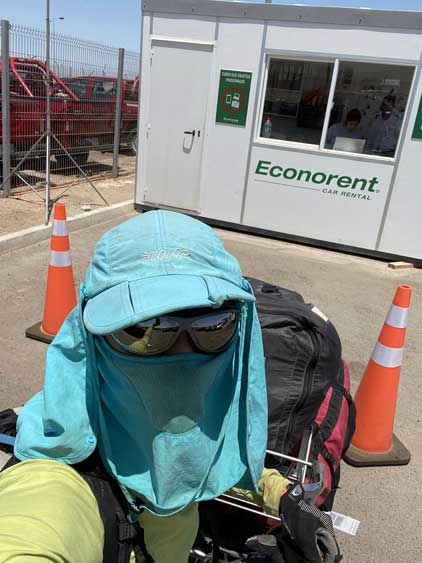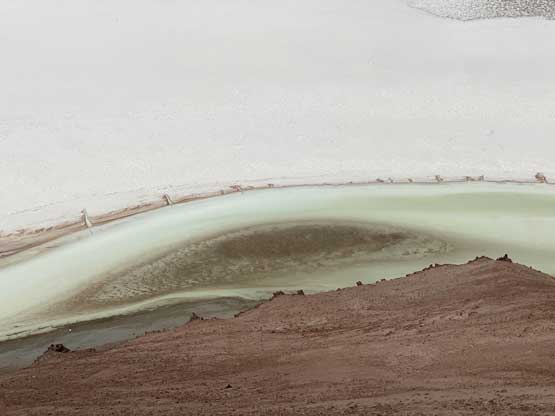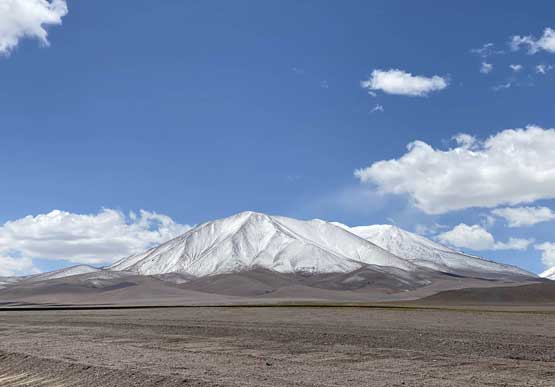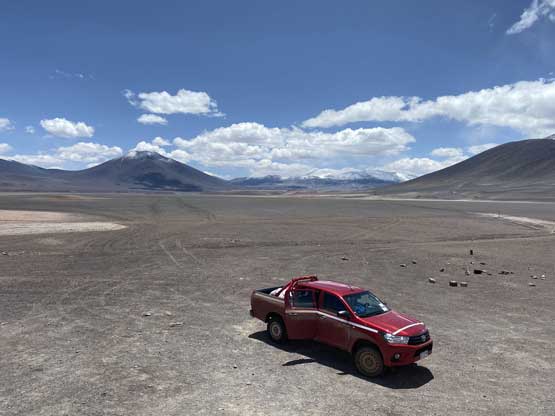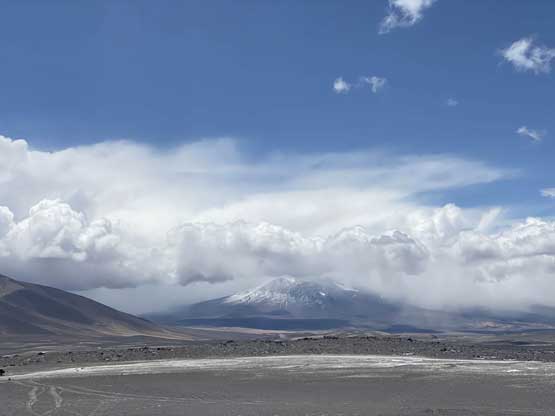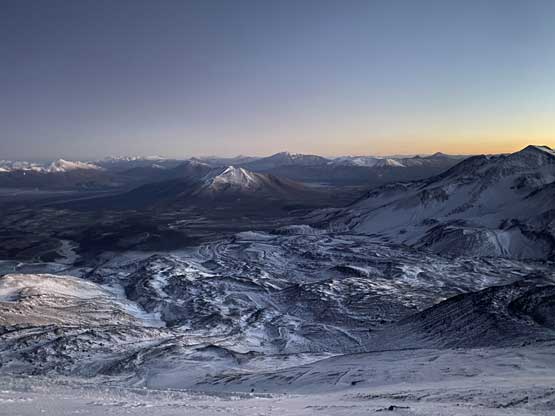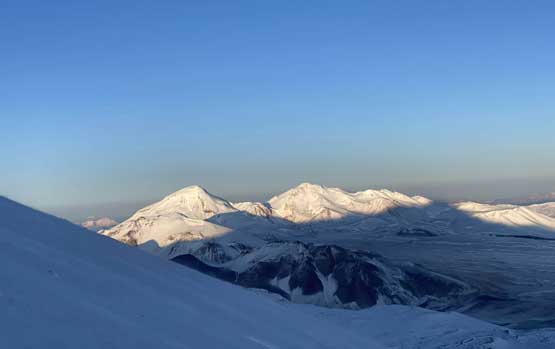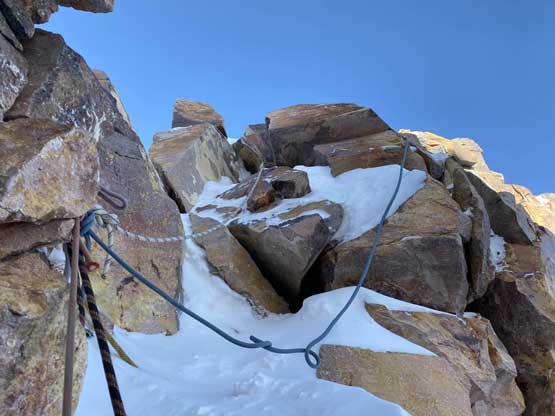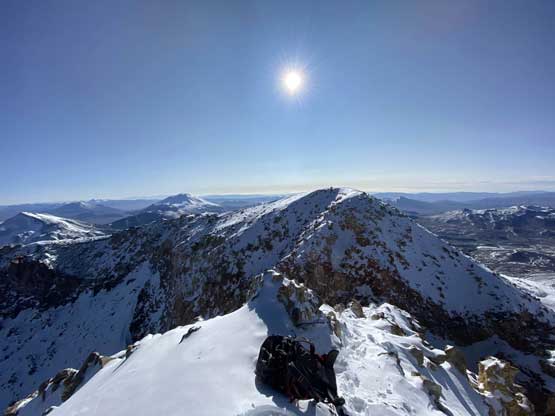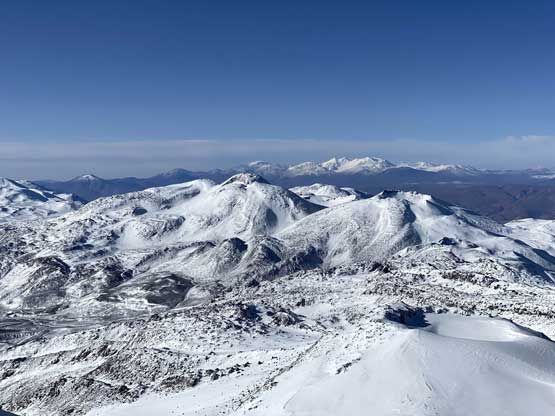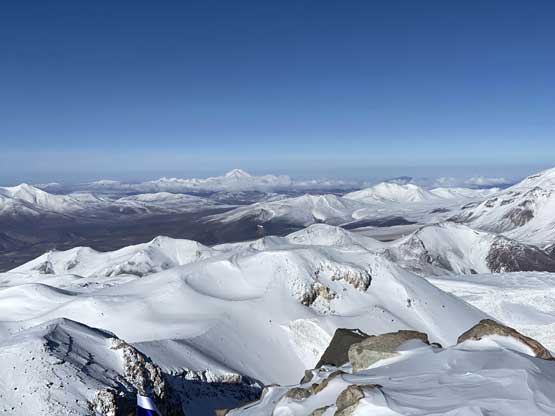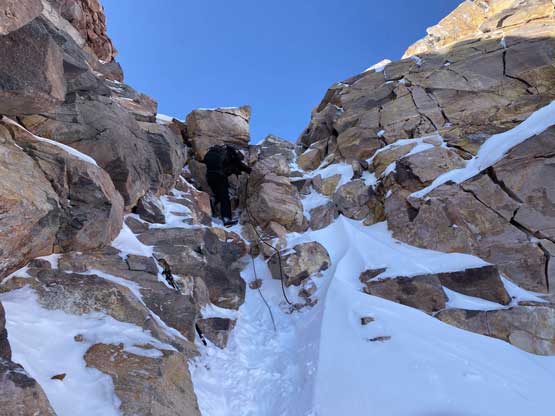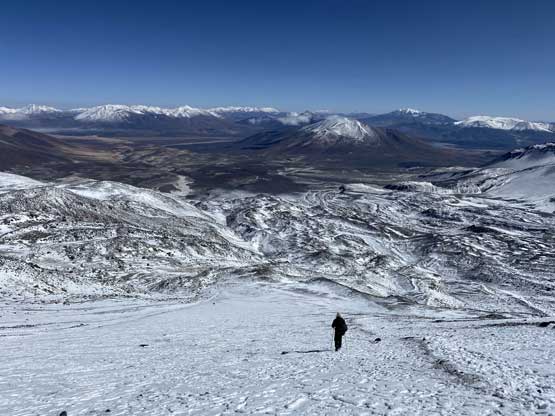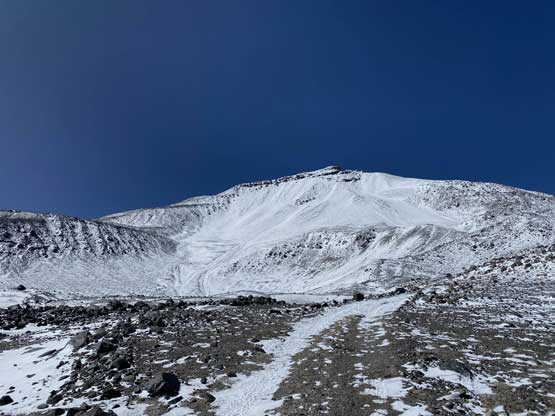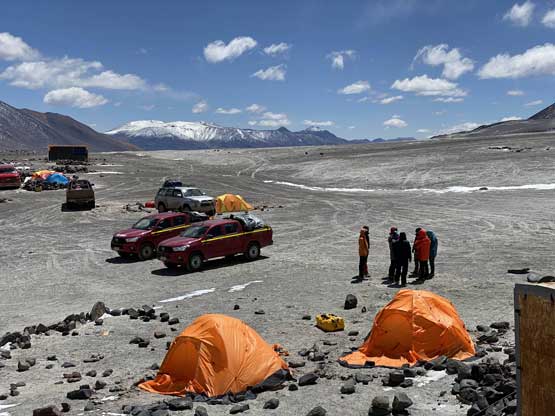Ojos del Salado
January 27-30, 2020
6893m
Copiapó / Puna de Atacama, Chile/Argentina
Nevado Ojos del Salado, or commonly known as just “Ojos del Salado” is the highest peak in Chile and the second highest in South America. Aconcagua to the south wins by around 70 m, although the measurements of the Andean peaks probably aren’t as accurate as those in North America. Historically Chile and Argentina had a long debate about the elevations of the three highest in South America hence who actually owns the highest peak, but nowadays it’s pretty well accepted that Aconcagua (Argentina) is the highest, Ojos del Salado (Chile/Argentina border) is the second and Monte Pissis (Argentina) is the third. The area around Ojos del Salado has a high density of 6000 m volcanoes even though they don’t appear to be that tall for several factors. Ojos del Salado locates in the Puna de Atacama region of the high Andes, an arid plateau where even the valley floors are about 4500 m above sea level so a 6000 m peak only has local relief of 2000 m. The arid climate means there aren’t many glaciers around and the volcanic origin of these peaks gives them rounded and dull profiles. From mountaineering perspective, the Atacama region of the Andes does not attract technical climbers but does provide a training ground for those new to high altitude mountaineering. Peak-baggers love this place as nowhere else on Earth offers such high density of easy 6000-m peaks. Most of them are walk-ups and the weather is as stable as one can expect, all year around except for during the “Invierno Boliviano” in January and February…
Connor, Dave and I came down to South America in hoping to climb Ojos del Salado and a few other 6000 m peaks and earlier in the trip we had already ascended Mercedario and Marmolejo. We were fully acclimated and were ready to hit the Atacama so we booked a flight from Santiago to Copiapó only to find out the peaks were coated by fresh snow. I thought the Atacama desert doesn’t see precipitation at all but apparently more than two feet of snow had fallen in the past two weeks. At Copiapó airport we met up with Matt Lemke who unfortunately had to deal with a break-in that ruined all of his plan to climb Ojos del Salado. Matt had met up with Sean O. (Dr. Dirtbag) a day earlier who summitted the peak two weeks ago with “a foot of snow”. Some important beta was passed from Sean to Matt and then to us. The condition on the mountain was very “out” and the weather was so bad that no one else summitted in the last week, but the weather forecast still called for a window on Wednesday, two days away from the day we landed in Copiapó. We had some discussion and decided to keep the original plan and embrace the snow. We definitely could have pulled the plug to fly wherever there’s no snow, but Ojos del Salado was the main objective in this whole trip and none of us wanted to come back home without it. We rented a Toyota Hilux (equivalent to Tacoma) directly from the airport from Econorent but learnt at the pick-up that the truck wasn’t equipped with all-terrain tires. We spent at least half an hour talking to them but to no avail. This meant we would drive the Atacama sand roads in just stock tires..

Ojos del Salado standard route from Chile. GPX DL
I also learnt right away that the rental vehicles outside Santiago are exclusively manual and this further means that for trips that involve renting a car/truck I must go with someone else that can drive… I had never thought that being able to drive manual transmission is a crucial skill to bag peaks in South America. Such skill is totally obsolete for those in their 20s living in big cities in Canada and USA… Such wasn’t a problem for Dave though as he easily drove us into the city of Copiapó. We made the first stop in a grocery store and because of Matt’s break-in I didn’t even go into the store. Instead, I stayed with our truck to watch the gears while Dave and Connor went in and grabbed some last-minute food and half a dozen jugs of water. The second stop was a gas station. We needed extra diesel for the truck and gasoline for our stoves.
And then we directly the vehicle towards Paso de San Franciso and off we went. The drive into the Atacama desert was nice and scenic and in an hour or so we started gaining elevation and in another half an hour we entered some thunderstorm cells. The gravel roads became muddy and slippery and we almost instantly needed 4 wheel drive. The roads climbed over a pass at 4350 m elevation and then descended towards a high plateau at 3800 m where the border control (and the permit check) located, and sure enough the gate was closed because of “a lot of snow and ice at Paso de San Francisco”. To climb Ojos del Salado one needs to apply permit through DIFROL at least a few weeks in advance and Connor had it all sorted out. Our permit was approved by the PDI at the border, but another hour later the 4350-m pass behind us was also closed so despite the paper work we were completely stuck. The elevation at Paso de San Franciso is 4800 m and we also wondered how bad the condition would be on our peak. Meanwhile it just kept pouring and thundering with no hope that the rain’s going to stop soon. Mountain Forecast called for “1-3 cm” of snow in this afternoon and it’s clearly useless. At least they allowed us to sleep in the border control’s room. The PDI directed us to a Chilean guide that happened to be nearby, and it was now that we learnt this Invierno Boliviano that we basically came here in the wrong season. In English it means the Bolivian winter or “winter in summer”. Apparently the afternoon thunderstorms are very common in the Bolivian Andes in January and February and they sometimes can creep south into the Puna de Atacama region, dumping feet of snow to the high volcanoes. The guides said the weather had been the same every day in the last 10 days.
The next morning we woke up at 7 or 8 am and had no idea whether or not they would open the gate on this particular day. The rain had stopped but it was overcast. At around 10 am the officials came and informed us that they needed a couple more hours to investigate the situation so I hiked a nearby hill to kill time. The clouds started to lift and I got some nice views of the desert. I got back to the border an hour and half later and they just opened the gate. We decided to at least see Ojos del Salado before making any decision. The drive to the start of the dirt road near Laguna Verde was very scenic with the snow-capped Nevado de Tres Cruces (6th highest in South America) stealing the show. I felt we were lucky enough to see the Atacama covered in snow and completely forgot that snow was no what we wanted… We were not able to see Ojos del Salado until pretty much at the start of the dirt road (4600 m) and the decision was to go, as we could see scree and rocks high up on the mountain indicating the snow was either packed, or not as deep as what we’d heard. The drive up to Atacama camp at 5200 m was indeed adventurous but not as bad as we had anticipated, even with the fresh snow. It took us something like 1.5 hours to cover the 15 km distance and we did have to switch to 4-Low towards the end. The number of vehicles and climbers on the mountain also surprised us. We parked our truck slightly higher than where everyone camped, and spent the next half an hour packing for the approach to the Tejos Refugio at 5840 m. It was already mid-afternoon, the storms were rolling in and the wind was picking up, but in order to catch the summit window on Wednesday we must get to Tejos on this day, so nobody said nor questioned anything on what we were doing. The plan was to be back here in 24 hours so I only brought one day’s food.
In addition to food and gears I also brought a 6 L of water jug to save me from having to melt snow at Tejos refugio. The approach was only 3.5 km long with 650 m elevation gain so how bad could that be. It turned out that I completely underestimated the effort to drag a 40lb backpack at 5500 m altitude, especially in shitty weather. The storm hit us half an hour after we started and in no time we were soaked in a blizzard. It also thundered us and we estimated the strikes were not very far away.. About halfway up I needed to stop and put my down pants on, as I forgot to wear long joins from the start. Learning to put on a brand new pair of down pants in the middle of a blizzard proved to be a shitty experience that I had no desire to repeat. I froze there for about 10 minutes and couldn’t figure out how the zippers worked. Dave caught me up from below and instantly pointed me out that the zip was “bottom-up”. Dave lives and climbs in Alaska so he knows the down gears. The rest of the slog to Tejos wasn’t as cold as before, but still miserable. In the refugio there were two climbers worrying about their teammates. They started at 2 am in the morning and it was 6 pm and they were still up there. It had been storming like this for a couple hours. It turned out later that they summitted at 3 pm when the thunderstorm rolled in, and returned at 8 or 9 pm in the dark… The downside for us – the refugio was completely full so we had to pitch the tents out and it was still howling and snowing outside… Needless to say, this had not been the “easy” day that I hoped for…
At midnight I went out and the sky had completely cleared but the wind was still stiff and the temperature was much colder than on Mercedario. I went back into the tent and waited for the alarm to go off at 3 am. Dave informed me that he “wasn’t feeling well” and “needed to wait till at least tomorrow” to attempt. The problem was, this day had the best weather forecast so I convinced myself that it’s this particular day or not happening. Connor never agreed with this “alpine start” thing so his decision was to start 1.5 hours later and catch me up. I was in no rush while cooking breakfast in the refugio as I could hear the wind was still howling outside. I eventually started at around 4:20 am, solo in pitch dark with no track to be seen. Five minutes later I found the upper end of the road and the tracks made by the party that summitted the day before. The lower part of the mountain was relatively sheltered and their tracks were nicely preserved. I did have to check my GPS a few times making sure I veered climber’s left on a couple spots. And then for a long while up to 6500 m elevation all I needed was to go straight up the slope. I could see some switchbacks and tracks but had to fight a constant head wind that forced me to climb in my parka. Looking back I could see one headlamp moving definitely faster than I was, so no doubt that was Connor. Behind him there were multiple lights moving at a slow pace and it looked like another party that drove up to Tejos from below. At around 6500 m my GPS track indicated a long rising traverse out to the right aiming for the right side skyline shoulder but I saw no track going that way. I assumed it’s buried by the wind so from this point onward I was on my own, breaking trail for the rest of the ascent. While traversing I hit a couple stiff wind slabs that forced me to strap the crampons on, even though they weren’t entirely necessary and I was soon back to post-holing. The reward of the hard work was also big as watching sunrise over the snowy Atacama from 6600 m altitude wasn’t something one gets to do often….
The aforementioned right side skyline ridge was mostly an easy plod but with some degree of post-holing. The snow wasn’t deep on the ridge thank to the wind, and this lasted until around 6750 m when I entered the summit crater. Inside the crater the wind completely died down but the snow was well preserved. There was probably 20 cm of fresh snow and the previous party’s tracks were completely covered. I could pick out where exactly they went but had to deal with knee+ deep of wallowing. I was forced to take a rest break but my donuts were frozen solid and hard to eat. I forced in one donut and drank some water-ice mixture and resumed the horizontal traverse towards the couloir that leads to the 4th class crux. The going was very tough but I somehow managed to maintain a steady pace. Connor crested the 6750-m rim into the crater when I just entered the couloir. The wallowing in the couloir was fucking exhausting but with less than 100 vertical meters to the summit all I needed was to breathe hard and be mentally strong. Half an hour later I was at the base of the 4th class crux. It was mixed climbing in this conditions but the 3 fixed ropes meant the summit was attainable. I dug out my harness and self-belayed using a prusik, and 15 minutes later I was on the summit. Connor joined me 5 minutes later. Despite the shitty conditions it only took me 5 hours from Tejos to the summit with a ton of trail-breaking. It only took Connor 3.5 hours. It might felt slow, but we were absolutely crushing it especially considering the party took 13 hours to summit on the previous day…
Considering the altitude, the conditions and the fact afternoon thunderstorms were a daily thing we had no time to linger on the summit. We also didn’t climb the “Argentinian summit” because there’s no fixed rope leading onto it. Thankfully the one we climbed (Chilean summit) was surveyed to be 40 cm taller than the other peak. Down-climbing the 4th class crux section still required a lot of care and I took my time self-belaying using the prusik as well. Plunging down the couloir and then back across the crater was physically easy but the hidden rocks underneath made us walking like a drunk pair. Connor had screwed up the route-finding in the 6500-6750 m zone as he missed the rising traverse that I did, so I led the two of us down the next stretch. Once the going became easier we took one long break forcing in some food before committing to the descent to Tejos refugio. At around 6400 m we passed the Russian team that started just after Connor in the morning. Given their position and pace we expected them to have an equally epic day as the previous day’s party. We got back at around 11 am, cooked some meal and chatted with the large Argentian group that’s about to head down. We thought Dave was sleeping so didn’t bother to wake him up. At around 3 pm we checked Dave’s tent and saw nobody so we thought he must have gone down to the truck for food. The storm rolled in as expected, not as intense as the previous day but still pretty bad. At 7 pm Dave still didn’t show up and we started to worry if something more serious happened. Thankfully both Dave and Connor had brought their inReach so we could communicate. At night we received a message from Dave that he’s sick and at Copiapó but it was too late to move anywhere so we were stuck in Tejos for another night. I did not want to spend another night at 5840 m altitude considering the amount of physical work we just did, but it seemed like we were going to have the refugio to ourselves and that was nice.
The next morning we got up and discussed our situation. I had no food but Dave left all of his food in his tent so I cooked his frozen cheese for breakfast. Connor then received a message that Dave had taken the truck down to Copiapó but he’s going back to get us from Atacama camp around noon. Connor and I would have to carry all of Dave’s gears down but that’s not a big deal. The pack wasn’t nearly as heavy as I thought as we had no food nor water at this point. Once down to camp Atacama we talked to the other teams including the Russians to make sure we could also hitch a ride back to Copiapó if we had to. We had to make a plan B in case Dave’s altitude sickness kicked in again and couldn’t drive up to 5200 m. A few hours later Dave showed up earlier than expected and we exchanged stories. The situation was pretty urgent for him with severe symptom of HACE. It’s also apparent that we weren’t going to do Volcán Copiapó on Friday as planned so drove all the way back down to the city of Copiapó.
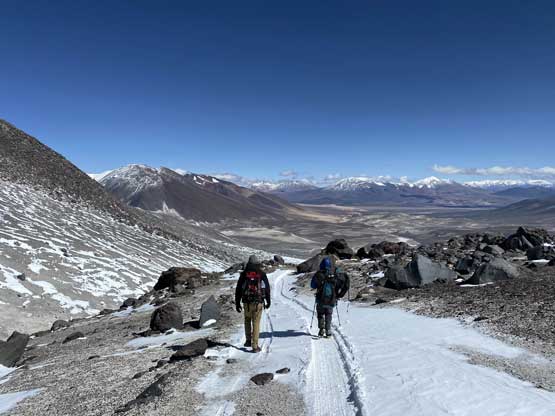
We teamed up with a French dude here. He attempted the summit this morning but turned back due to cold and wind and helped us to carry some of Dave’s gears down to Atacama. He planned to try again in a couple days.
We booked our hotel rooms in the city and went for a big dinner. Copiapó isn’t my favourate city in Chile but the dinner was extremely good. It was Thursday night and we had more decisions to make. Dave would fly back to Alaska on Saturday so he would spend another day and night in Copiapó but Connor and I had one more week and we wanted to climb more 6000 m peaks. The weather looked good further north near Bolivian border but it’s almost certain that those peaks had lots of snow. We figured that they wouldn’t be worse than what we just did so opted to chase the sun. Connor booked us a truck through Econorent in Antofagasta and 5 am bus tickets to Antofagasta. The hour seemed a wee bit too early to be comfortable but we wanted to make sure we had enough time to ride to Antofagasta (6 hours), rent a truck and then drive to Volcán Llullaillaco on the next day. The assumption we made about snow condition turned out to be a bold one and the ascent of Volcán Llullaillaco, the 7th highest in South America turned out to be significantly harder than Ojos del Salado…
